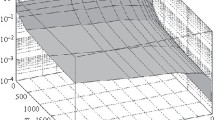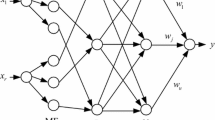Abstract
Traffic congestion is easy to occur in multimedia networks, so fuzzy adaptive prediction of data transmission congestion is conducted to improve the stability of multimedia networks. A fuzzy adaptive prediction algorithm for data transmission congestion in multimedia networks is proposed. The data transmission structure model of multimedia networks is established, and the data transmission congestion status feature extraction and time series analysis are conducted. The self-coherent matched filter detection algorithm is adopted to analyze the congestion state of data transmission, and the high-order cumulant feature extraction and post-focus search are carried out on the output filtered data, and the accurate detection and extraction of abnormal features in traffic sequence is realized. It can be concluded that the fuzzy adaptive prediction of data transmission congestion in multimedia network is accurate and has strong resistance to interference. After 10 rounds of iteration, the detection probability always keeps at a high level and rises steadily, and the minimum detection probability is 78%, which ensures the stability and security of multimedia network.









Similar content being viewed by others
References
Gao, Z. W., Cecati, C., & Ding, S. X. (2015). A survey of fault diagnosis and fault-tolerant techniques-part I: Fault diagnosis with model-based and signal-based approaches. IEEE Transactions on Industrial Electronics, 6(62), 3757–3767.
Guo, C. Y., Yang, Z. Z., Ning, L. R., et al. (2017). A novel coordinated control approach for commutation failure mitigation in hybrid parallel-HVDC system with MMC-HVDC and LCC-HVDC. Electric Power Components and Systems, 45(16), 1773–1782.
Egea-Alvarez, A., Fekriasl, S., Hassan, F., et al. (2015). Advanced vector control for voltage source converters connected to weak grids. IEEE Transactions on Power Systems, 30(6), 3072–3081.
Guo, C. Y., Zhao, C. Y., Iravani, R., et al. (2017). Impact of phase-locked loop on small-signal dynamics of the line commutated converter-based high-voltage direct-current station. IET Generation, Transmission & Distribution, 11(5), 1311–1318.
Li, T., & Zhao, C. Y. (2015). Recovering the modular multilevel converter from a cleared or isolated fault. IET Generation, Transmission & Distribution, 9(6), 550–559.
Wang, K., Liu, Y., Liu, X. P., et al. (2019). Adaptive fuzzy funnel congestion control for TCP/AQM network. ISA transactions, 95, 11–17.
Bao, X. H., Shang, X. L., & Wang, H. X. (2019). Congestion optimization control method for delay network data transmission. Journal of Inner Mongolia University for Nationalities (Natural Sciences), 34(01), 22–26.
Najm, I. A., Hamoud, A. K., Lloret, J., et al. (2019). Machine learning prediction approach to enhance congestion control in 5g iot environment. Electronics, 8(6), 607–614.
Tao WJ, Lu Y, Wei X, et al. (2019) Software implementation of precision clock synchronization based on PTPd2. Computer Engineering, 45(3): 47–53, 59.
Li, C. F., & Chen, Q. K. (2019). GPU cluster power consumption collection and monitoring system based on sensor. Computer Engineering, 45(3), 65–72.
Pan, C. S., Jia, Y. R., Cai, R. Y., et al. (2019). Routing strategy for spatial information network based on MPLS. Computer Engineering, 45(3), 85–90.
Zhu, F., Wang, H. Y., & Zhang, J. (2019). Fine-grained pedestrian detection algorithm based on improved mask R-CNN. Journal of Computer Applications, 39(11), 3210–3215.
Lee, G. M., & Lee, J. H. (2015). On nonsmooth optimality theorems for robust multiobjective optimization problems. Journal of Nonlinear and Convex Analysis, 16(10), 2039–2052.
Wang, W. T., Huang, Y., Wu, L. T., et al. (2019). Network representation learning algorithm based on improved random walk. Journal of Computer Applications, 39(3), 651–655.
Girshick, R., Donahue, J., Darrell, T., et al. (2016). Region-based convolutional networks for accurate object detection and segmentation. IEEE Transactions on Pattern Analysis and Machine Intelligence, 38(1), 142–158.
Wang, H. F. (2017). Discussion on optimized management of network data security storage. Information Security and Technology, 8(5), 63–66.
Wu, W. (2017). Security management technology of computer network database. Scientific and Technological Innovation in Formation, 8, 146–149.
Xue, C., Zhou, C. C., & Mei, C. L. (2017). Progress of research on network database for polycystic kidney disease. Chinese Journal of Kidney Disease Investigation (Electronic Version), 6(1), 31–33.
Hao CL, Chen M, Sun W, et al. (2018) Real-time traffic monitoring and analysis of network data in power information system. Electrical Measurement & Instrumentation, 56(8).
Yu, H. (2019). Optimal design of nbi-snubber multi-terminal power monitoring system. Journal of Jiamusi University (Natural Science Edition), 37(3), 403–406.
Li, H., Shen, H. W., Huang, W., et al. (2018). Research overview of geo-social networks data visualization and analysis. Journal of Chinese Information Processing, 32(10), 134–138.
Tao, Z. Y. (2017). Data compression algorithm of sensor network based on dynamically adjusting threshold of transmission coding. Journal of Jilin University, 55(4), 947–951.
Zhang, Y. L., Dong, Y., Ren, X. H., et al. (2017). Investigation on data source distribution of scientific collaboration network. Library Journal, 14(5), 24–28.
Ruan, F., & Wan, B. (2018). Simulation of network data transmission to prevent attack security assessment. Computer Simulation, 35(7), 25–31.
Ranjbaran, M., Mohammadi, R., Yaseri, M., et al. (2020). Effect of ambient air pollution and temperature on the risk of stillbirth: A distributed lag nonlinear time series analysis. Journal of Environmental Health Science and Engineering, 18(2), 1–11.
Stark, T. H., & Krosnick, J. A. (2017). GENSI: A new graphical tool to collect ego-centered network data. Social Networks, 48(5), 36–45.
He, Z., Cai, Z., & Yu, J. (2017). Latent-data privacy preserving with customized data utility for social network data. IEEE Transactions on Vehicular Technology, 12(99), 1–5.
Gao, W., Farahani, M. R., Aslam, A., et al. (2017). Distance learning techniques for ontology similarity measuring and ontology mapping. Cluster Computing-the Journal of Networks Software Tools and Applications, 20(2), 959–968.
Xiong, Z., Wu, Y., Ye, C., et al. (2019). Color image chaos encryption algorithm combining CRC and nine palace map. Multimedia Tools and Applications, 22(78), 31035–31055.
Breza E, Chandrasekhar AG, Mccormick TH, et al. (2017) Using aggregated relational data to feasibly identify network structure without network data. Nber Working Papers, 15(12): 121–125.
Arpino, B., Benedictis, L. D., & Mattei, A. (2017). Implementing propensity score matching with network data: The effect of the general agreement on tariffs and trade on bilateral trade. Journal of the Royal Statistical Society, 66(3), 537–554.
Cao, B., et al. (2020). Multiobjective evolution of fuzzy rough neural network via distributed parallelism for stock prediction. IEEE Transactions on Fuzzy Systems, 28(5), 939–952.
Xu W, et al. (2020) An improved adaptive sliding mode observer for a middle and high-speed rotors tracking. IEEE Transactions on Power Electronics, 1–1.
Evans, R. D., Petropavlovskikh, I., Mcclurebegley, A., et al. (2017). Technical note: The US Dobson station network data record prior to 2015, re-evaluation of NDACC and WOUDC archived records with WinDobson processing software. ResearchGate, 17(19), 12051–12070.
Cao B, Fan S, Zhao J, Yang P, Muhammad K, Tanveer M (2020) Quantum-enhanced multiobjective large-scale optimization via parallelism. Swarm Evol Comput, 57: 100697.
Ni, T., Liu, D., Xu, Q., Huang, Z., Liang, H., & Yan, A. (2020). Architecture of cobweb-based redundant TSV for clustered faults. IEEE T Vlsi Syst, 28(7), 1736–1739.
Shi, K., et al. (2018). Nonfragile asynchronous control for uncertain chaotic Lurie network systems with Bernoulli stochastic process. International Journal of Robust and Nonlinear Control, 28(5), 1693–1714.
Shi, K., et al. (2017). Non-fragile sampled-data robust synchronization of uncertain delayed chaotic Lurie systems with randomly occurring controller gain fluctuation. ISA Transactions, 66, 185–199.
Naeem, M., Siddiqui, M. K., et al. (2018). New and modified eccentric indices of octagonal grid Omn. Applied Mathematics & Nonlinear Sciences, 3(1), 209–228.
Zuo, C., et al. (2015). Transport of intensity phase retrieval and computational imaging for partially coherent fields: The phase space perspective. Optics and Lasers in Engineering, 71, 20–32.
Wu, J., Yuan, J., et al. (2019). Analysis of fractional factor system for data transmission in SDN. Applied Mathematics and Nonlinear Sciences, 4(1), 191–196.
Lv, Z., & Xiu, W. (2020). Interaction of edge-cloud computing based on SDN and NFV for next generation IOT. IEEE Internet of Things Journal, 7(7), 5706–5712.
Wu C, Wang X, Chen M, Kim MJ (2019) Differential received signal strength based RFID positioning for construction equipment tracking. Adv Eng Inform, 42: 100960.
Zuo C, Li J, Sun J, Fan Y, Zhang J, Lu L, Zhang R, Wang B, Huang L, Chen Q (2020) Transport of intensity equation: A tutorial. Opt Laser Eng, 106187.
Funding
The study is supported in part by research funds from Sehan University in Korea, 2021. This research was funded by the 2021 Provincial and Municipal Joint Fund Project of the Natural Science Foundation of Hunan Province (No. 2021JJ50149).
Author information
Authors and Affiliations
Corresponding author
Ethics declarations
Conflict of interest
The authors declared that there is no conflict of interest.
Data availability
The datasets used and/or analyzed during the current study are available.
Additional information
Publisher's Note
Springer Nature remains neutral with regard to jurisdictional claims in published maps and institutional affiliations.
Rights and permissions
About this article
Cite this article
Liu, H., Ko, Y.C. Fuzzy self-adaptive prediction method for data transmission congestion of multimedia network. Wireless Netw 28, 2775–2784 (2022). https://doi.org/10.1007/s11276-021-02749-1
Accepted:
Published:
Issue Date:
DOI: https://doi.org/10.1007/s11276-021-02749-1




